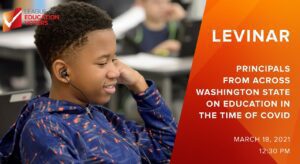By Alice Doyel
Guest blogger

Less than 80% of Washington state first-time 9th graders are “on track” to pass all credits they attempted in 9th grade. Black, Latinx, Native American, and Pacific Islanders fall below this percent. Students in the following categories also fall below: foster care, homelessness, 504/special education, English language learner, migrant, and low-income. Males as a group follow below this 80% mark.
The group of students falling below the 80% “on track” level are the same students with the most school exclusions, the most school exclusion days, and the most students with 10+ exclusion days in a year.
In 2020, 83% of high school students graduated, 8% continued their high school education in the following year(s) and may or may not eventually graduate, and 9% dropped out. In 2021 there are 91,712 twelfth graders. Assume percentages similar to 2020, 8,254 students will drop out, and 7,337 will continue. That is over 15,000 students we fail to educate in a timely manner.
This figure does not include students who dropped out before twelfth grade. Absenteeism may be an indicator of early dropping out. In fifth grade, 94% of students attend regularly. This percentage drops for each grade, with only 80% of twelfth grade students attending school regularly.
Source for all the above information: Washington State Report Card, Diversity Report.
How Do We Increase the Graduation Rate?
- Stop the School-to-Prison Pipeline with a Moratorium on School Exclusions for all but truly endangering student actions.
- Use the Supportive Alternatives for Students found on the WA OSPI Discipline Website.
 League of Education Voters LEVinar: Principals Reimagining Education
League of Education Voters LEVinar: Principals Reimagining Education
If you have not yet viewed this LEVinar, please do so! Especially the portion beginning at 23:30 minutes. Here are a few of their thoughts, but hearing it all is far more meaningful:
- “It would be academic malpractice to go back to doing things exactly the way we’ve done them before.”
- The principals all learned from schooling during COVID. They needed to understand how each student learned. There was more contact with families. Some students excelled at distance learning.
- Disregard deadlines; focus on what is learned. Change grading practice, where A and A- look different for college entry. Consider getting rid of the grading system. Get rid of standardized testing.
- Put an elementary school student in multiple grades depending on her specific abilities. The student may be in math at 4th grade level, while in language arts at 2nd grade level. Most elementary school teachers are better at either math or language. Let them teach the classes that they are best at, giving students the best learning opportunity.
- Teach students how to discipline themselves through time management and organizational skills. Teach them self-advocacy.
- Year-Around-School, so learning is not lost, especially for students most at risk.
 Cedar Law attorney Chris Williams: Design for a Year-Around-School Plan.
Cedar Law attorney Chris Williams: Design for a Year-Around-School Plan.
School would run four weeks on and two weeks off all year round. This would provide teachers time without direct pressure from their work and reduce burnout. Students could use the regular time off to catch up with schoolwork. Students would have free intermittent time for their personal lives. If a district divided up its schools in clusters, it could reduce the number of buses and janitorial staff by always having one cluster ‘off’ so this staff could rotate over to the other schools. Out-of-school summer activity programs could also then plan on running year-round instead of gearing up for summer hiring every year.

Alice (Me): A World of Exciting and Evolving Occupations Abound, But Most High School Students Are Not Aware of These Opportunities.
Dedicate a substantial portion of eighth grade to teaching students about these expansive opportunities using speakers, podcasts, videos, books, professional journals, discussion groups. These opportunities abound in biological and physical sciences, creative arts, technology, humanities, teaching, business, law, engineering, public service, and more. Students would be provided the time and means to study their area of interest in depth.
When a student gets excited about a career, then school has meaning, they have a focus for school and life, they can set goals, they willingly put in time and energy. The students would see role models, women and men of all ethnicities, a rainbow of gender identities, with varied educational backgrounds, who have unique perspectives of our world and the universe.
Successful professionals would talk directly and interactively to students remotely or in person. People who enjoy and succeed in their professions want to share with young people, to bring the students possibilities for their future.
 Dr. Jessica Watkins is an astronaut and geologist, currently analyzing rocks and soil from Mars. In the following video, Jessica tells how she took her dream to success one step at a time, showing young people that reaching your dream is achievable: Meet NASA Astronaut & Artemis Team Member Jessica Watkins (2:18 minutes)
Dr. Jessica Watkins is an astronaut and geologist, currently analyzing rocks and soil from Mars. In the following video, Jessica tells how she took her dream to success one step at a time, showing young people that reaching your dream is achievable: Meet NASA Astronaut & Artemis Team Member Jessica Watkins (2:18 minutes)
We Achieve Equality when Diverse Students Succeed Through Education.
When They become Practitioners, Teachers, Professors, Researchers.
Seattle’s Child (June 2020) reports: In 2015 White students made up 46% of the Seattle School district population, but were 72% of Highly Capable (HC) eligible students. 16% of students were black, but only 1% were in Advanced Learning programs. The striking disparities in HC eligible for all BIPOC students are grossly unjust. The HC imbalance means BIPOC students are less likely to be aware of these exciting career opportunities than White students who predominantly make up the HC students. This imbalance must change!
Every Student Must See Their Inner Genius and Their Potential for Changing Our World.
Next Blog Post: Overwhelming Increase in Suicides by 10- to 24-Year-Olds
Joyful Activity: View the superb Japanese woodblock prints of Hasui Kawase.
Hasui Kawase (1883 – 1957) dreamt of an art career. He studied under great artists. Unhappily, his parents wanted him to manage the family wholesale rope and thread business. This business went bankrupt when Hasui was 26, allowing him to return to his artwork. In 1956 Hasui was designated a Living National Treasure by the Japanese government.